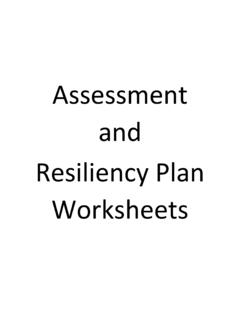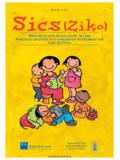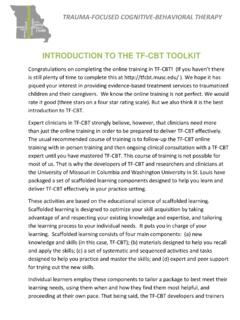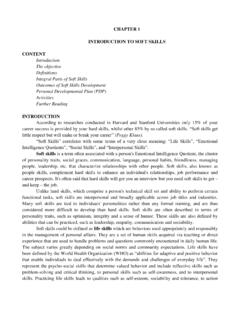Transcription of SELF AND PERSONALITY - NCERT
1 Chapter 2 Self and Personality23 IntroductionSelf and PersonalityConcept of SelfCognitive and Behavioural Aspects of SelfSelf- esteem , Self-efficacy and Self-regulationCulture and SelfConcept of PersonalityPersonality-related Terms (Box )Major Approaches to the Study of PersonalityType ApproachesTrait ApproachesFive-Factor Model of PERSONALITY (Box )Psychodynamic ApproachBehavioural ApproachCultural ApproachHumanistic ApproachWho is a Healthy Person? (Box )Assessment of PersonalitySelf-report MeasuresProjective TechniquesBehavioural Analysis Key TermsSummaryReview QuestionsProject IdeasWeblinksPedagogical HintsAfter reading this chapter, you would be able to:describe the concept of self and learn some ways for self-regulation of behaviour,explain the concept of PERSONALITY ,differentiate between various approaches to the study of PERSONALITY ,develop insight into the development of a healthy PERSONALITY , anddescribe some techniques for PERSONALITY OF SELFFrom your childhood days, you may havespent considerable time thinking aboutwho you are, and how you are differentfrom others.
2 By now, you already may havedeveloped some ideas about yourself,although you may not be aware of it. Letus try to have some preliminary notion ofour self ( who are we?) by completingActivity easy was it for you to completethese sentences? How much time did youtake? Perhaps it was not as easy as youmay have thought at first. While workingon it, you were describing your self . Youare aware of your self in the same way asyou are aware of various objects in yoursurrounding environment, such as a chairor a table in your room. A newly born childhas no idea of its self. As a child growsSELF AND PERSONALITYSelf and PERSONALITY refer to thecharacteristic ways in which we define ourexistence.
3 They also refer to the ways inwhich our experiences are organised andshow up in our behaviour. From commonobservation we know that different peoplehold different ideas about ideas represent the self of a also know that different people behavein different ways in a given situation, butthe behaviour of a particular person fromone situation to another generally remainsfairly stable. Such a relatively stablepattern of behaviour represents the PERSONALITY of that person. Thus, differentpersons seem to possess differentpersonalities. These personalities arereflected in the diverse behaviour often you must have found yourself engaged in knowing andevaluating your own behaviour and that of others.
4 You must have noticedhow you react and behave in certain situations in a manner different fromothers? You may have also often asked questions about your relationshipswith others. To find an answer to some of these questions, psychologistsuse the notion of self. Similarly when we ask questions such as why peopleare different, how they make different meaning of events, and how theyfeel and react differently in similar situations ( questions relating tovariations in behaviour), the notion of PERSONALITY comes into play. Boththese concepts, self and PERSONALITY are intimately related. Self, in fact,lies at the core of study of self and PERSONALITY helps us understand not only who weare, but also our uniqueness as well as our similarities with others.
5 Byunderstanding self and PERSONALITY , we can understand our own as wellas others behaviour in diverse settings. Several thinkers have analysedthe structure and function of self and PERSONALITY . As a result, we havedifferent theoretical perspectives on self and PERSONALITY today. This chapterwill introduce you to some basic aspects of self and PERSONALITY . You willalso learn some important theoretical approaches to self and PERSONALITY ,and certain methods of PERSONALITY assessment. 2022-23 Chapter 2 Self and Personality25older, the idea of self emerges and itsformation begins. Parents, friends,teachers and other significant persons playa vital role in shaping a child s ideas aboutself.
6 Our interaction with other people, ourexperiences, and the meaning we give tothem, serve as the basis of our self. Thestructure of self is modifiable in the lightof our own experiences and theexperiences we have of other people. Thisyou will notice if you exchange the list youcompleted under Activity with yourother her/his personal identity. Socialidentity refers to those aspects of a personthat link her/him to a social or culturalgroup or are derived from it. Whensomeone says that s/he is a Hindu or aMuslim, a Brahmin or an adivasi or aNorth Indian or a South Indian, orsomething like these, s/he is trying toindicate her/his social identity.
7 Thesedescriptions characterise the way peoplementally represent themselves as a , self refers to the totality of anindividual s conscious experiences, ideas,thoughts and feelings with regard to herselfor himself. These experiences and ideasdefine the existence of an individual bothat the personal and at social as Subject and Self as ObjectIf you return to your friends descriptionsin Activity , you will find that they havedescribed themselves either as an entitythat does something ( , I am a dancer)or as an entity on which something is done( , I am one who easily gets hurt). In theformer case, the self is described as a subject (who does something); in the lattercase, the self is described as an object (which gets affected).
8 This means that self can be understoodas a subject as well as an object. When yousay, I know who I am , the self is beingdescribed as a knower as well assomething that can be known . As asubject (actor) the self actively engages inthe process of knowing itself. As an object(consequence) the self gets observed andcomes to be known. This dual status of selfshould always be kept in of SelfThere are several kinds of self. They getformed as a result of our interactions withour physical and socio-culturalenvironments. The first elements of selfmay be noticed when a newborn child criesUnderstanding the SelfPlease complete the following sentencesstarting with I am.
9 Time when you Notice what they have done. You willfind that they have produced a fairly longlist of attributes about how they identifythemselves. The attributes they have usedfor identification tell us about theirpersonal as well as social or culturalidentities. Personal identity refers to thoseattributes of a person that make her/himdifferent from others. When a persondescribes herself/himself by telling her/hisname ( , I am Sanjana or Karim), or her/his qualities or characteristics ( , I amhonest or hardworking person), or her/hispotentialities or capabilities ( , I am asinger or dancer), or her/his beliefs ( ,I am a believer in God or destiny), s/he is2022-23 Psychology26for milk when it is hungry.
10 Although, thiscry is based on reflex, this later on leadsto development of awareness that I amhungry . This biological self in the contextof socio-cultural environment modifiesitself. While you may feel hungry for achocolate, an Eskimo may distinction is made between personal and social self. The personal self leads toan orientation in which one feels primarilyconcerned with oneself. We have talkedabove how our biological needs lead to thedevelopment of a biological self . But, soona child s psychological and social needs inthe context of her/his environment leadother components of personal self toemerge. Emphasis comes to be laid onthose aspects of life that relate only to theconcerned person, such as personalfreedom, personal responsibility, personalachievement, or personal comforts.














